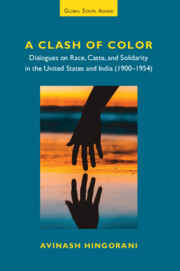 A Clash of Color
A Clash of Color Published online by Cambridge University Press: 28 November 2024
While there are many vital words at the heart of Indo-American histories, Indian, caste, and thug are all uniquely connected to Indo-American relations – and to the struggle for democracy in both countries.
—Nico SlateBlack Americans and Indians built many connections to combat White supremacy and they positioned the Black American and Indian struggle as part of a global movement for equality, as W. E. B. Du Bois and Lala Lajpat Rai commonly emphasized. They utilized each other to modify their aspirations for their respective societies and achieve a meaningful social impact, particularly in the US. However, this impact largely occurred after Indian independence through the efforts of Black radicals such as Du Bois, Paul Robeson, and William Patterson who identified India as a source of sympathy for the Black American cause because Indians were similarly victimized by White supremacy under the British Raj.
Caste was not a colonial invention and, therefore, the end of British colonialism did not result in its annihilation and some caste elements of British colonialism have remained in India. One of the most striking parallels regarding how African Americans and Dalits remain marginalized is the persistence of “criminal castes.” Although some low-caste Indians could access education, land, and better jobs during the British Raj, occupational specialization was generally accepted as a defining characteristic of castes and tribes, even to the extent of defining certain tribal communities as “habitually” criminal under the Criminal Tribes Act. Originally passed by the British government in 1871, the British used the act to categorize some communities across the country as “born criminals,” irrespective of their criminal precedents. The act required adult male members of such groups to have weekly meetings with the local police and they were not allowed to leave their villages without permission. The categorizations had no basis in criminal evidence and were merely based upon racial and caste stereotypes. The British government initially proposed the act to reform “born criminals” through labor. However, when these “born criminals” attempted to make a living like members from other castes, they struggled to find work outside the settlement because of public prejudice and marginalization.
To save this book to your Kindle, first ensure [email protected] is added to your Approved Personal Document E-mail List under your Personal Document Settings on the Manage Your Content and Devices page of your Amazon account. Then enter the ‘name’ part of your Kindle email address below. Find out more about saving to your Kindle.
Note you can select to save to either the @free.kindle.com or @kindle.com variations. ‘@free.kindle.com’ emails are free but can only be saved to your device when it is connected to wi-fi. ‘@kindle.com’ emails can be delivered even when you are not connected to wi-fi, but note that service fees apply.
Find out more about the Kindle Personal Document Service.
To save content items to your account, please confirm that you agree to abide by our usage policies. If this is the first time you use this feature, you will be asked to authorise Cambridge Core to connect with your account. Find out more about saving content to Dropbox.
To save content items to your account, please confirm that you agree to abide by our usage policies. If this is the first time you use this feature, you will be asked to authorise Cambridge Core to connect with your account. Find out more about saving content to Google Drive.